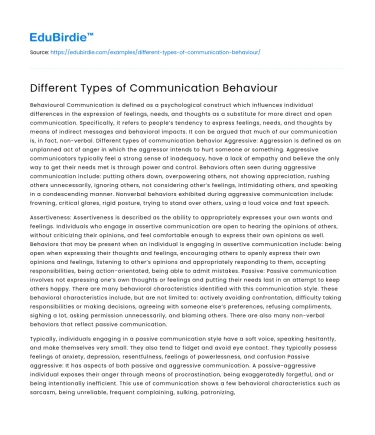Behavioural Communication is defined as a psychological construct which influences individual differences in the expression of feelings, needs, and thoughts as a substitute for more direct and open communication. Specifically, it refers to people’s tendency to express feelings, needs, and thoughts by means of indirect messages and behavioral impacts. It can be argued that much of our communication is, in fact, non-verbal. Different types of communication behavior Aggressive: Aggression is defined as an unplanned act of anger in which the aggressor intends to hurt someone or something. Aggressive communicators typically feel a strong sense of inadequacy, have a lack of empathy and believe the only way to get their needs met is through power and control. Behaviors often seen during aggressive communication include: putting others down, overpowering others, not showing appreciation, rushing others unnecessarily, ignoring others, not considering other’s feelings, intimidating others, and speaking in a condescending manner. Nonverbal behaviors exhibited during aggressive communication include: frowning, critical glares, rigid posture, trying to stand over others, using a loud voice and fast speech.
Assertiveness: Assertiveness is described as the ability to appropriately expresses your own wants and feelings. Individuals who engage in assertive communication are open to hearing the opinions of others, without criticizing their opinions, and feel comfortable enough to express their own opinions as well. Behaviors that may be present when an individual is engaging in assertive communication include: being open when expressing their thoughts and feelings, encouraging others to openly express their own opinions and feelings, listening to other’s opinions and appropriately responding to them, accepting responsibilities, being action-orientated, being able to admit mistakes. Passive: Passive communication involves not expressing one’s own thoughts or feelings and putting their needs last in an attempt to keep others happy. There are many behavioral characteristics identified with this communication style. These behavioral characteristics include, but are not limited to: actively avoiding confrontation, difficulty taking responsibilities or making decisions, agreeing with someone else’s preferences, refusing compliments, sighing a lot, asking permission unnecessarily, and blaming others. There are also many non-verbal behaviors that reflect passive communication.
Save your time!
We can take care of your essay
- Proper editing and formatting
- Free revision, title page, and bibliography
- Flexible prices and money-back guarantee
Typically, individuals engaging in a passive communication style have a soft voice, speaking hesitantly, and make themselves very small. They also tend to fidget and avoid eye contact. They typically possess feelings of anxiety, depression, resentfulness, feelings of powerlessness, and confusion Passive aggressive: It has aspects of both passive and aggressive communication. A passive-aggressive individual exposes their anger through means of procrastination, being exaggeratedly forgetful, and or being intentionally inefficient. This use of communication shows a few behavioral characteristics such as sarcasm, being unreliable, frequent complaining, sulking, patronizing, and gossiping. In order to not show their anger, they may conceal it with an innocent facial expression. Cognitive communication model is to do with the processes of your brain and brain activity.
Cognitive communication skills that are important are attention, memory, problemsolving, organization and memory flexibility. These are important because they mean its easier to communicate such as attention means you have to keep focused and keep your brain focused in the conversation. Also having memory flexibility means you can put the more important information you need to remember before anything Psychoanalytical communication theory was first introduced by a trained Sigmund Freud. Through the analysis, he found a person personality can be evaluated off a person’s past experiences as these characterize a person behavior and shape us. Psychoanalytic theories are a complex set of theories and principles to understand and to study the human behavior, personality, logic, and thoughts of a person.






 Stuck on your essay?
Stuck on your essay?

